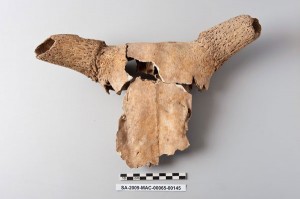The Sagalassos team intends to fulfill its responsibility for the creation of a management plan for the long-term preservation of the site. The methodology of the process entails following steps: 1. definitions: – define the area and the scope of the plan, – define the objectives – identify the stakeholders and decision makers 2. data […]
Read full post »Archives for the ‘Studies & Data’ Category
Site Management: 2010 Aims
Friday, July 9, 2010Macrobotany: 2010 Aims
Friday, July 9, 2010Introduction Macrobotanical remains, consisting of seeds, fruits and wood charcoal will be collected in the trenches and in the sieves, and will be identified. Aims The aim of the research is to reconstruct the former environment and to document the exploitation of that environment by the inhabitants of the site for food and as a […]
Read full post »Geomorphology: 2010 Aims
Friday, July 9, 2010Introduction The geomorphological approach on the site of Sagalassos involves: 1) the study of the geomorphological characteristics of the different terrain units where the town is build and the different buildings are situated, and 2) the study of the impact of geomorphological processes on the site during and after the occupation. Aims The aim of […]
Read full post »Archaeozoology: 2010 Aims
Friday, July 9, 2010Introduction Animal remains will be collected in the trenches and in the sieves, and will be identified to species. Aims The aim of the research is to document the food procurement strategies of the inhabitants of the site (importance of domestic stock keeping, of hunting and of fishing), and to reconstruct the former environment. Methodology […]
Read full post »Archaeological Studies: 2010 Aims
Friday, July 9, 2010Pottery studies The territorial survey campaigns, as well as the intensive suburban and urban survey work, and the excavation programmes at Sagalassos and D?ºzen Tepe, have resulted in the outline of ceramic production and use within the territory of ancient Sagalassos between the Iron Age and mid-Byzantine times. During the 2010 campaign, the general aim […]
Read full post »Anthropobiology: 2010 Aims
Friday, July 9, 2010Introduction Anthropobiology is based on the determination of the biological features of past and present human individuals/populations in order to reconstruct their origin, history and evolution. Aims The aims of the anthropo-biological work that will take place during the 2010 campaign in Sagalassos will be to analyze the biological features of the human remains, especially […]
Read full post »Ancient DNA Research: 2010 Aims
Friday, July 9, 2010Introduction Ancient DNA research provides the possibility to study the environment and history of past human populations by the analysis of DNA from biological archaeological finds such as animal, human and botanical remains. Aims It is our aim to provide complementary data to the research performed by other disciplines in Sagalassos such as the pottery […]
Read full post »Archaeozoology
Friday, October 16, 2009
A large amount of animal remains have been studied since the very beginning of the excavations at Sagalassos. The analyses yielded information on several aspects of daily life in the city, from the Iron Age (at Tepe Düzen) up to the Middle Byzantine period. The data collected during the 2009 campaign corroborated earlier results and […]
Read full post »Macrobotany
Wednesday, October 14, 2009
During the 2009 excavation season, the archaeobotanical studies at the site continued with extensive sampling of all of the excavated locations in order to get more representative information on the plant economy of the city of Sagalassos and its Iron Age predecessor Tepe Düzen. A total of 75 flotation and 23 wood charcoal samples were […]
Read full post »Depot Management
Thursday, September 17, 2009A professor once said “archaeology is 10 percent digging and 90 percent figuring out what to do with your stuff”. There could not have been more truth in his words, implying that getting it out of the ground is one thing, but studying and storing it yet another. Indeed, as archaeologists we should provide the […]
Read full post »
